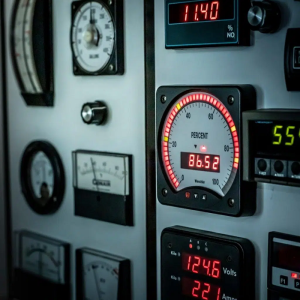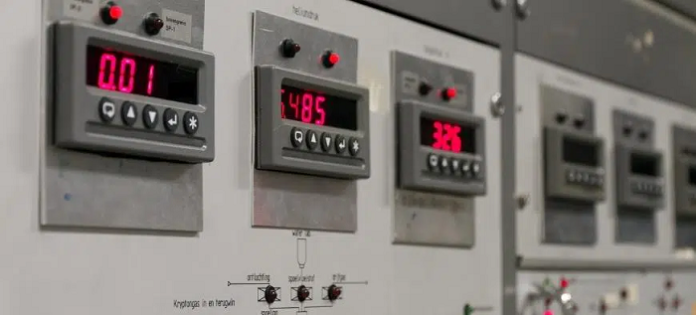Explore the Latest Automotive Technologies and Solutions from Metravi Instruments exclusively at Auto EV India 2022 from 9th to 11th November 2022 at KTPO Bengaluru.
Panel meters are electronic instruments that display a signal input in analogue or digital format. Some panel meters have extra features like the ability to transfer data to other devices like computers and alarm options, etc.

Analogue Panel Meters have an interface specific to applications and display the measured unit for the input signal, which is representative of the process.
They can display Voltage, Current, Frequency, Speed, Temperature, etc. The actual input signals need to be in analogue voltage or current, either AC or DC.
What are Analogue Panel Meters?
Analogue Panel Meters have two ways for displaying the readings. A taut band with a needle suspended between two ribbons of metal, which is ideal for environments prone to shocks. The other, a pivot and jewel, where the pointer has better stability for higher vibration environments.

What are Digital Panel Meters?
Digital Panel Meters are usually intended to be mounted in Control Panels. They read some type of input, like voltage, current, frequency, resistance, etc., and display the value digitally. Quite often, this input may be a measurement from a sensor, which is then converted and displayed as temperature, pressure or other system variables.
Digital Panel Meters can also act as controllers that can trip a switch or perform simple functions, triggered when the reading reaches a preset measurement.
How to select a Digital Panel Meter?
Industrial buyers have to first decide what function they would like the Digital Panel Meter to perform.
Input Signal and Display Output
The basic function of all Digital Panel Meters is to take an input signal and convert to a displayed value. The control panel provides power for the device and the required inputs for the meter display. The input comes from a sensor in the system or process and is sent to the device using the panel that the meter is connected to.
Additional Outputs
Some Digital Panel Meters may also have optional control or interface functions:
- Analogue Functionality can provide analogue output proportionate to the input signal (like variable voltage or current), for use in analogue devices.
- Data Interface functionality enables interaction with the output information that is displayed, for analytical use.
- Set Point functionality enables user to preset input values which will trigger simple control functions or alarms, as the case may be. The related on/off functions correspond to either solid state or electromechanical relay outputs depending on the design of the meter and panel.
What are the types of Digital Panel Meters?
The types of Digital Panel Meter differ by the type of display as well as the lighting technology used, along with the functionality required.
Displays for Digital Panel Meters can be:
- Numeric: that display only numbers. Most digital panel meters come with numeric displays as their main purpose is to display numeric values of the input.
- Alpha-numeric: that displays numbers along with letters. These are useful in providing further details regarding the values displayed, such as the measurement reading’s channel, units, etc.
Display Lighting technology used for Digital Panel Meters can be:
- LED displays: made of light emitting diodes which can be seen in the dark
- LCD displays: liquid crystal displays that consume less power than LEDs but require a backlight to be seen in the dark. Otherwise, they are just dark/black digits across a blank grey or green screen.
Signal Input for Digital Panel Meters must be designed to accept the analogue input sent to them and can be of various types:
AC Voltage: Input received is in measurable form of AC Voltage in VAC (Volts AC)
AC Current: Input received is in measurable form of AC Current in A AC (AC Amperes) or mA AC (AC Milliamperes)
AC Power: Input received in an adjustable range of AC Voltage, Current and/or Frequency
DC Voltage: Input received is in measurable form of DC Voltage in VAC (Volts AC)
DC Current: Input received is in measurable form of DC Current in A AC (AC Amperes) or mA AC (AC Milliamperes)
DC Power: Input received in an adjustable range of DC Voltage, Current and/or Frequency
Temperature: Input is received via a temperature sensor like a thermocouple, RTD or thermistor
Resistance: Input is received from elements measuring changes in resistance, such as strain gauges or piezoresistive sensors
What specifications to consider when selecting Digital Panel Meters?
The number of digits, the size of the panel and the display colour are to be considered when selecting Digital Panel Meters. These are important specifications and need to be taken into account.
Number of Digits
The number of digits determine how many digits are present in the display output. This number should be less than or equal to the number of significant figures in the signal input, depending on the accuracy desired. In meters rated to display half digits (e.g. 4.5 digits, 2.5 digits), the first or the last digit can only be ‘1’ or off, or ‘5’ or off. This “half” digit allows for the upper limits of display to be extended (1000 vs. _999) or allows for the display of intermediate values (100.5 vs. 100_).
Size
The size of the panel face determines the device’s physical compatibility with the panel it is to be mounted on. Typically, face sizes are rated in inches (” or in) or millimeters (mm) and are specified by length and width. Sometimes, the depth of the meter and the dimensions of the cutout need to be considered, though most panels will accept standard depths associated with the face size. Additionally, the display should be large enough for the user to read the digits/letters comfortably when mounted.
Colour
Digital panel meters are designed to display certain colours. In LCD meters, the colour is determined by the backlight behind the black digits. In LED meters, the colour is determined by the type of diodes built in to the device.
Red is the default LED colour and often LCDs have no backlight (no colour). Multicolour options exist, which are particularly useful when multiple displays or channels are used. Setting one colour to each display can help users quickly identify the measurements.
Connections
The connections for digital display meters include both the electrical inputs and outputs and the physical connections (e.g. screw connectors) essential for secure mounting to the panel. These connections must be compatible with the design and provisions of the associated control panel.

What kind of optional features are available in Digital Panel Meters?
Digital panel meters may incorporate a number of extra features that provide the device with additional functionality. These include set point options, alarms, on/off controls, and adjustable displays.
- Set point options provide the ability to set control limits or set points for process parameters such as speed, temperature, pressure or humidity. In a heating application, the unit sends an off control signal when the set point temperature is approached or exceeded and an on control signal when the temperature drops below the set point.
- Alarms (either audible or visual) may be built in to the meter to indicate when limits or set points are reached.
- On/off control allows the meter to send an on-off output signal to activate or deactivate a process unit (oven, motor, fan, etc.) utilising relays, open collector transistors, or other technologies. On-off, bang-bang, or limit control is one of the simplest techniques for process control.
- Adjustable display allows the meter to be adjusted to show different displays.
- Additional channels allow digital panel meters to receive and interpret multiple signals from different sources.
- USB/serial ports allow the meter to be connected to other devices such as data-analysis tools or computers via USB or serial connectors.
Courtesy: Metravi









